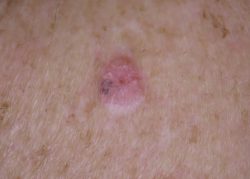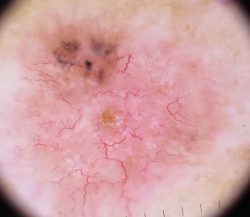
Invasive BCC
Basal Cell Carcinomas (BCCs) are the most common skin cancers, accounting for around 70% of non-melanoma cases. They are slow growing and very rarely fatal but are important to find as they destroy local tissues, ulcerate and disfigure the skin. BCCs can appear anywhere on the body but appear most commonly on areas with high sun exposure, such as the face, neck, shoulders and back. Symptoms of a Basal Cell Carcinoma include a slow growing pearly skin lump or a scaly dry area that is shiny and pale (sometimes scar-like) or bright pink in colour. They may bleed spontaneously or from minimal trauma.
Risk factors for BCCs are:
- Excessive exposure to UV radiation, especially during childhood
- Fair skin
- Advanced age
- Male gender
- Past history of non-melanoma skin cancers
- Family history of multiple BCCs
- Medications that suppress the immune system
- Previous treatment for cancer including radiotherapy and chemotherapy

BCC (dermatoscopic view)
Diagnosis of Basal Cell Carcinoma is made using a combination of dermatoscopic examination and/or biopsy. Treatment is determined by how thick or invasive the lesion is. Where the BCC is only small and superficial, the treatment can include phototherapy, cryotherapy, topical creams such as Imiquimod, as well as surgical options like curettage and excision. For larger or more aggressive BCCs, surgical removal by excision is the main treatment. In some cases of advanced BCC or where lesions are in difficult locations (e.g. on the eyelid) then referral to a surgeon may be necessary. A minority of cases also require the use of radiotherapy, especially for large tumours with nerve involvement.
